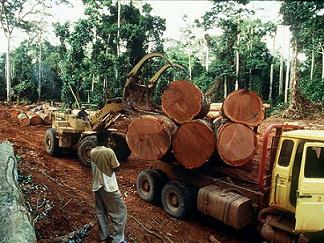|
The future of rain forests

|
People are rapidly destroying the world's rain forests. In 1950, rain forests covered about 8,700,000 square miles (22,533,000 square kilometers) of the earth. This area would cover about three-fourths of Africa. Today, less than half the original extent of the earth's rain forest remains.
In such regions as Madagascar, Sumatra, and the Atlantic coast of Brazil, only small patches still stand. Few rain forest species can adjust to severe disturbance of their habitat. Most perish when people clear large areas of forest. Scientists estimate that tropical deforestation (clearing of trees) wipes out about 7,500 species per year. |
Causes of deforestation. Commercial logging and the expansion of agriculture have damaged or wiped out extensive areas of rain forest. Huge mining projects, the construction of hydroelectric dams, and government resettlement programs have also taken their toll.
A complex mix of social, political, and economic factors has triggered these destructive activities. Rapid population growth and poverty often intensify the pressure to clear rain forest for short-term economic benefits. Brazil, Indonesia, and other nations have cut down huge expanses of rain forest to create new settlements that allow people to move out of overcrowded cities. Moreover, the governments of many tropical countries are deeply in debt. This debt provides a strong motivation to gather as much as possible from the rain forest as quickly as possible. After clearing the forest to harvest wood and other products, people then commonly use the land to grow crops.
Deforestation usually displaces forest peoples. When denied access to the forest, these peoples often lose important knowledge about rain forest species and their uses. Loss of such knowledge further threatens the survival of the forests.
Saving rain forests. Many conservation organizations, including the World Wildlife Fund, Conservation International, and the Nature Conservancy, are working with governments to conserve rain forests. Such efforts include (1) establishing protected areas, (2) promoting intelligent management of rain forests, and (3) increasing public awareness about the importance of the forests.
In the 1980's and 1990's, hundreds of protected areas were established in tropical forests. These areas included nature reserves, wildlife sanctuaries, and national parks. However, such efforts affected only a small percentage of the total area of rain forest. Moreover, many conservation areas remain only "paper parks," with little protection or enforcement on the ground.
|
Governments and conservation organizations also promote sound management of tropical forests by the people who use them. For example, certain organizations certify timber from loggers that harvest rain forest wood in a sustainable fashion. Certified timbers may bring a higher price on the international market. Areas of some rain forests have been set aside as extractive reserves. Local populations manage these reserves and practice sustainable harvesting of many forest products.
Increasing public awareness about the plight of rain forests may also aid the struggle to conserve them. Awareness has grown due to greater exposure of rain forest issues in the media, and to an increasing number of tourists who travel to rain forests.
Next >>> |
Contributor:
Charles M. Peters, Ph.D., Kate E. Tode Curator of Botany, The New York Botanical Garden.
..
|
|

